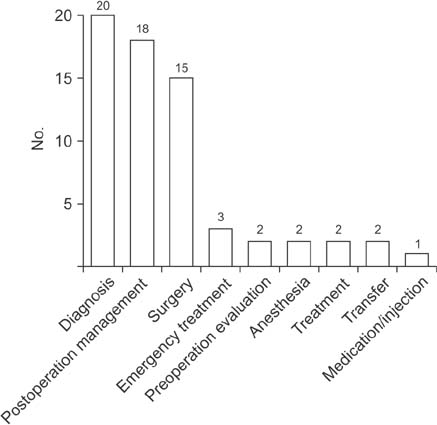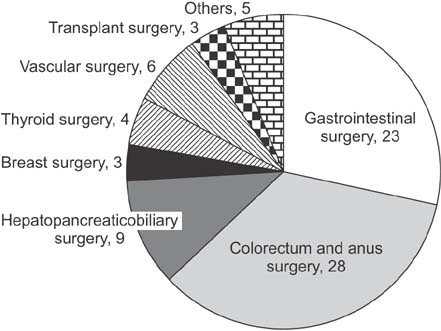Ann Surg Treat Res.
2018 Mar;94(3):113-117. 10.4174/astr.2018.94.3.113.
Analysis of lawsuit cases in the Department of Surgery in Korea
- Affiliations
-
- 1Center of Bio & Basic Science R&D Coordination, Korea Institute of S&T Evaluation and Planning (KISTEP), Seoul, Korea.
- 2Department of Medical Law & Ethics, Yonsei University College of Medicine, Seoul, Korea. one0308@yuhs.ac
- 3Asian Institute for Bioethics and Health Law, Seoul, Korea.
- 4Department of Surgery, Severance Hospital, Yonsei University of Medicine, Seoul, Korea.
- 5Korea Medical Dispute Mediation and Arbitration Agency, Seoul, Korea.
- 6Department of Surgery, Chung-Ang University Hospital, Chung-Ang University College of Medicine, Seoul, Korea.
- 7Department of Surgery, College of Medicine, The Catholic University of Korea, Seoul, Korea.
- KMID: 2405322
- DOI: http://doi.org/10.4174/astr.2018.94.3.113
Abstract
- PURPOSE
The aim of this study is to prepare medical staff in order to prevent medical malpractice litigation through analysis of litigation cases related to the department of surgery in Korea.
METHODS
A total of 94 litigation cases related to the department of surgery, where a certain amount of payment was ordered to the defendant between 2005 through 2010, were analyzed. We examined time of occurrence, amount claimed and awarded in damages, plaintiff claims, and court opinion.
RESULTS
An average of 3.2 years was spent from the date of the incident occurring to the end of the litigation procedures. The average amount awarded in judgments for damages was 59,708,983 ± 67,307,264 (range, 1,700,000-365,201,482) Korean won. Cases were found involving the following opinion of the court: violation of duty of care (49 cases), violation of informed consent (7 cases), violation of duty of care and informed consent (5 cases), and settlement, reconciliation, and others (32 cases). By analyzing defendants' negligence in court opinions, diagnosis (30.8%) was the most common, followed by post-operation management (27.7%).
CONCLUSION
Physicians have to conduct treatment and surgery based on exact diagnosis and be careful to observe patients' conditions and symptoms after surgery. It is essential to identify the current status and characteristics of medical litigation for reducing further litigation and improving patient safety. In order to create a safe medical environment, national efforts should be made not only by individuals but also at the national level.
Keyword
MeSH Terms
Figure
Cited by 1 articles
-
Trends in medical disputes involving anesthesia during July 2009–June 2018: an analysis of the Korean Society of Anesthesiologists database
Ji Won Choi, Duk Kyung Kim, Choon Kyu Cho, Soo Jung Park, Yong Hun Son
Korean J Anesthesiol. 2019;72(2):156-163. doi: 10.4097/kja.d.18.00198.
Reference
-
1. Supreme Court of Korea. Jurisdiction annual report (2005-2015). Seoul: Supreme Court of Korea;2005. 2015.2. Korea Consumer Agency. Annual report and casebook on consumer remedy damage (2005-2015). Eumseong: Korea Consumer Agency;2006. 2016.3. Korea Medical Dispute Mediation and Arbitration Agency. Medical dispute mediation and arbitration statistical yearbook 2015. Seoul: Korea Medical Dispute Mediation and Arbitration Agency;2016. p. 334.4. Shin EH. A study for analysis of the current status of medical disputes and the characteristics by medical department: centered on the data of 2006 Korea Consumer Agency. Seoul: Graduate school of Public Health Yonsei University;2007.5. Min HY. A study on the significantly influential factors of malpractice suit. Seoul: Yonsei University;1997.6. Im B. Analysis of medical disputes precedent. J Korea Content Assoc. 2010; 10:294–303.
Article7. Kim SY. Research on the costs associated with medical accidents to improve the relative value of risk. Seoul: Health Insurance Review & Assessment Service;2012.8. Seo SY. The actual condition of the surgeon's patient safety and infection control activities in the operating room. Daegu: Graduate School of Forensic and Investigative Science, Kyungpook National University;2014.9. Bae H, Noh H, Jang HY, Jung KY. Medicolegal consideration of acute appendicitis: based on judicial precedents. J Korean Surg Soc. 2007; 72:223–229.10. Sobel DL, Loughlin KR, Coogan CL. Medical malpractice liability in clinical urology: a survey of practicing urologists. J Urol. 2006; 175:1847–1851.
Article11. Awad MA, Osterberg EC, Chang H, Gaither TW, Alwaal A, Fox R, et al. Urethral catheters and medical malpractice: a legal database review from 1965 to 2015. Transl Androl Urol. 2016; 5:762–773.
Article12. Kim C, Shon MS. A judicial precedent analysis on medical malpractice in internal medicine. Korean J Med Law. 2000; 7:21–48.13. Park BY, Pak JH, Hong SE, Kang SR. The legal doctrine on 'limitation of liability' in the precedent analysis on plastic surgery medical malpractice lawsuits. J Korean Med Sci. 2015; 30:1718–1722.
Article14. Park BY, Kim MJ, Kang SR, Hong SE. A legal analysis of the precedents of medical disputes in the cosmetic surgery field. Arch Plast Surg. 2016; 43:278–283.
Article15. Seo HK. If you do not explain general-anesthesia to the patient when it is given, you will be fined 3 million won. Yonhapnews [Internet]. 2017. 3. 9. cited 2017 May 12. Available from: http://www.yonhapnews.co.kr/bulletin/2017/03/08/0200000000AKR20170308111000017.HTML?input=1195m.16. Park BY, Kwon J, Kang SR, Hong SE. Informed consent as a litigation strategy in the field of aesthetic surgery: an analysis based on court precedents. Arch Plast Surg. 2016; 43:402–410.
Article17. MacDonald OW. Physician perspectives on preventing diagnostic errors [Internet]. Waltham (MA): QuantiaMD;2011. cited 2017 May 12. Available from: https://secure.quantiamd.com/q-qcp/QuantiaMD_PreventingDiagnosticErrors_Whitepaper_1.pdf.18. The Korean Society for Patient Safety. Patient safety: concept and application. Seoul: Parkyoungsa;2016. p. 452.19. Park BY, Kim MJ, Kang SR, Hong SE. Legal issues related to postoperative pulmonary thromboembolism in Korea. Ann Surg Treat Res. 2016; 91:316–322.
Article
- Full Text Links
- Actions
-
Cited
- CITED
-
- Close
- Share
- Similar articles
-
- Application of Epidemiology to the Tobacco Lawsuit Cases in KOREA
- Analysis of Medical Malpractice Claims and Future Object in the Emergency Department
- Case Analysis of Medical Dispute About plastic Surgery
- A Study on the Current Status of Medical Lawsuits in Orthopedics in Korea
- Analysis of Medical Litigations Associated with Keratorefractive Surgery in Korea



